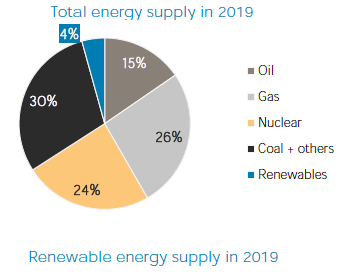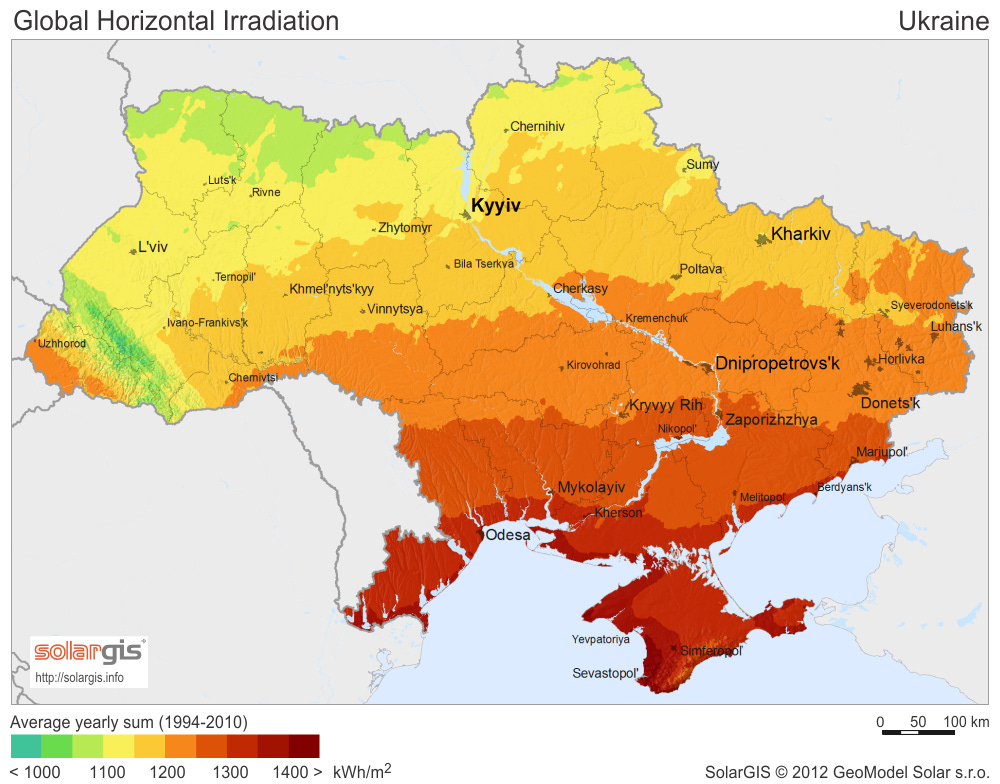But first, a Word from Our Sponsor…
If you enjoy this column, please consider sharing it with your friends by e-mail, social media, or whatever other medium you prefer. I don’t charge for this column because I’d like to help people become more informed citizens. Many of you have given me positive feedback, so please feel free to spread the word by clicking on the link below and choosing your preferred medium.
Why the Green Energy Transition Promotes Resilience and Stability
The resilience of Ukraine’s electrical grid demonstrates the value in transitioning to green energy, which is inherently flexible, decentralized, and responsive to variable demand. Like most industrial countries, Ukraine began the war with a highly centralized electrical power system dependent on large power stations fueled by coal, nuclear, and hydroelectric energy. Russian attacks destroyed large portions of Ukraine’s power grid, forced the shutdown of the largest nuclear power station in Europe, and caused massive flooding and power loss by wrecking the Kakhova Dam and Hydroelectric Project, all of which likely constitute violations of international humanitarian law. In response, Ukraine immediately invested in solar panels to provide emergency power to critical infrastructure like hospitals and police stations, continued construction of wind farms, and began planning the move to small modular reactors for nuclear power stations after the war. They are building resilience and adaptability while reducing threats to citizens and the climate.

Prior to the war, Ukraine received only 4% of its power from renewable sources. With significant coal deposits in the country and with Russian natural gas pipelines critical to the rest of Europe crossing its territory, Ukraine felt secure in its energy supplies. War changed that. Unable to win with attacks in military infrastructure, Russia quickly started targeting the civilian power infrastructure, in an attempt to cow the population into submission. To add insult to injury, the occupation cost Ukraine most of its wind farms.
Centralized grids emanating from large power stations are highly susceptible to disruption. Even if the facilities remain intact, it takes only dropping carbon filaments on transmission lines to disrupt distribution. Further, unified grids sometimes either distribute power to enemy-occupied areas or are dependent on generation from them. One of my colleagues in Afghanistan, a B-52 pilot, had the unenviable task of trying to boost energy generation at the ill-fated Kajaki Dam through the installation of a new generator. Unfortunately, the route to the dam was subject to frequent attack. Furthermore, the Taliban occupied much of the distribution grid and funded their operations by selling power from it. And even in the best case, operation of the dam was going to rely indefinitely on foreign support, unlike the locally-sustainable micro-hydro and solar projects advocated by sustainable development experts. When the pilot’s efforts to kill Kajaki project finally succeeded, I congratulated him on being the only B-52 pilot to earn local gratitude by “destroying” a dam.

Critics of renewables often point to the fluctuating power generation of renewables from the day/night cycle and wind variability. But, as my colleague pointed out to the Afghan government (and is true in all war zones), the jump from no power to some power is of much greater importance than the speculative jump from some power to full-time, reliable power. Further, the distributed nature of the solar projects and their connection to critical civil government infrastructure means that they are both difficult to disrupt and directly attached to the buildings most important for resilience in an area. These are the same reasons that Oregon requires an investment of a small percentage of the cost of every public building in renewables.
Ukraine also has a long-term commitment to accommodate this variability with carbon-free dispatchable energy sources—that is, sources that can readily be turned on or off to meet variable needs. Large nuclear and coal plants, often called “thermal” plants, have difficulty increasing or decreasing energy in response to demand; they are not sufficiently dispatchable. However, Ukraine has invested in pumped storage hydro power and plans to convert many of its large nuclear thermal plants to small nuclear reactors, increasing both safety and dispatchability. The short-term patchwork of local renewables will thus eventually serve as the foundation of a long-term system that enjoys clean, reliable power after the post-war reconstruction.
When completed and in conjunction with Western Europe’s weaning off Russian gas, this conversion will also provide greater stability for the region. Instead of being dependent on Russia’s unstable autocracy, the rest of Europe will increasingly be energy self-sufficient. Ukraine will no longer have to rely on transmitting Russian gas to support its economy. Rather than a forced unification with Ukraine, Russia’s actions will have caused not only a permanent divorce, but also the diminution of Russia’s influence on the whole continent.
Ukraine’s transition from a hydrocarbon-dependent, highly centralized system to a renewable, decentralized one represents a kind of death bed conversion. While none of us would wish the violence and destruction of the war on our Ukrainian friends, we can admire their commitment to move forward, not back, when confronted with this energy challenge. We can also learn from their example by following through on the promise of the Inflation Reduction Act to speed our own energy transition. While we do not face an invasion, we face the certainty of more fires from climate change, the probability of widespread grid damage from a major earthquake, and the health impacts of pollution from hydrocarbon use. Following their example in speeding our own transition will provide us with a safer, more secure future as well.
What’s Next in Ukraine
As I write this, Ukraine’s military has started their summer offensive. As I wrote earlier, we are likely to know relatively quickly whether it will be successful. So far, Ukrainian forces have repeatedly broken through the first line of Russian defenses, but not yet to achieve the kind of breakthrough that would change the overall picture. I recommend the incomparable Institute for the Study of War for reliable, open source updates and thoughtful analysis. Their interactive map is also quite useful.
Department of Inconvenient Truths - Fire Insurance Office
Reduced to its essentials, insurance is a subsidy from a low-risk group to a high-risk group, with the middleman taking a (hopefully) small percentage to run the system. Many times, we think that this is a reasonable compromise. Few people now question the wisdom of subsidizing health insurance for people approaching retirement and, while we may not be thrilled with subsidizing younger drivers through auto insurance, we understand the necessity. In this light, there’s a lot of sympathy for homeowners who live in areas at high risk for wildfire damage. After all, they (usually) do not cause the fires and any of us could be impacted by a similar event. For that reason, there’s been a certain amount of condemnation for State Farm and Allstate for refusing to issue new policies in California. The Oregon Legislature even passed a bill preventing the use of wildfire risk maps to support insurance premium determinations.
But let me ask you, how much more are you willing to pay on your home insurance bill to support people who engage in unsafe practices? While people with houses in the woods can’t easily move their residences, they can engage in basic fire mitigation practices like storing flammable substances safely, keeping vegetation back from their homes, ensuring access for emergency vehicles, and the other practices recommended by the Firewise USA program. Drive up the McKenzie and you can still see a number of homes that almost certainly would have been destroyed, but for the foresight of their owners in taking these precautions.
Here’s the problem - people don’t LIKE doing these things. They involve work or expense. And they’re generally happy to have YOU subsidize the increased risk. Sure, we can and probably will quibble about fire risk maps for years, but it’s long past time to create a separate risk pool for folks who can’t show that they take basic precautions to reduce the risk of fire damage to their properties. Sure, we can’t make people stop from storing gas cans next to their houses, but we can sure stop subsidizing their decision to do so. Another approach is to allow risk maps for fire insurance, but provide a discount for owners in high-risk areas who can prove that they comply with reasonable precautions. People respond to incentives. Let’s build some positive ones into the system.
15-17 Year Olds and Healthcare Decision Making
We’ve seen a lot of debate lately about HB 2002’s provisions to allow minors under age 15 to consent to abortion and other reproductive healthcare, but little about the actual enforcement of the law allowing those 15-17 to make their own healthcare decisions. To be clear, under an existing Oregon law, minors 15 and older may make their own healthcare decisions. As the father of a (very independent-minded) 17-year-old, I can tell you that it’s more observed in the breach. Our family has routinely fought with our local pharmacy over our child’s authority to pick up their own (non-controlled substance) prescriptions, as well as with an imaging center over the authority to consent to radiological studies. Our insurance company continues to provide me with explanations of benefits with their private healthcare information. While these violations of their legal rights were more annoying than substantive, I’d dearly love to see the state actually enforce its own policies.








I'm a RADICAL! I think all LIFE ON EARTH IS SACRED! I also BELIEVE that when HUMANS SPREAD INDIVIDUAL RISKS AMONGST OTHER HUMANS, that's SOCIALISM! We label it as Insurance, but what we're buying is shared risk just like why we have Fire Departments, Police, Life, Health and Auto Insurance the Government, the Military AND THE FDIC!
Great discussion of a variety of topics. With regards to the fire insurance, yes, its time to evaluate the cost to those of us who follow basic fire prevention strategies with those who choose to live deep in the forest and ignore instructions about defensible space rules. Home owners in the heavily forrested areas should have annual inspections to determine their actual risk and if they chose not to mitigate their risks, then their rates should reflect their decision. Just like young drivers and very old drivers are allowed to buy car insurance, their rates do reflect the fact that are at higher risk for accidents. People with bad driving records pay more and i would equate that to dangerous vegetation and inaccessible access for emergency response from fire fighters. Premiums have always been higher for young and old drivers. I live in a flood plain and had to produce an elevation certificate for my house to help reduce the cost of my flood insurance. The risk you agree to should only be applied to others in the "risk pool" if you as a responsible person, have done all you can to mitigate the risk.(i.e. take drivers ed, or in the case of older people a driving assessment, or for wild land home owners, applied tge defensible space rules to your property)
Thanks
Marie Wilson